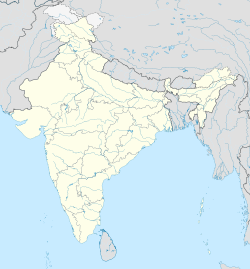Davanagere
| Davanagere ದಾವಣಗೆರೆ | ||
|---|---|---|
| Staat: | ||
| Bundesstaat: | Karnataka | |
| Distrikt: | Davanagere | |
| Subdistrikt: | Davanagere | |
| Lage: | 14° 28′ N, 75° 55′ O | |
| Höhe: | 599 m | |
| Fläche: | 68,63 km² | |
| Einwohner: | 434.971 (2011)[1] | |
| Bevölkerungsdichte: | 6338 Ew./km² | |
| Website: | www.davanagerecity.mrc.gov.in | |
| GM Institute of Technology | ||
Davanagere (auch: Davangere, Kannada: ದಾವಣಗೆರೆ Dāvaṇagere [ˈd̪aːʋʌɲʌɡere]) ist eine Stadt im indischen Bundesstaat Karnataka.
Sie liegt in Zentralkarnataka 256 Kilometer nordwestlich der Hauptstadt Bengaluru. Mit rund 435.000 Einwohnern (Volkszählung 2011) ist Davanagere die siebtgrößte Stadt des Bundesstaates. Die Stadt ist Verwaltungssitz des Distrikts Davanagere. Des Weiteren besitzt die Stadt seit dem 6. Januar 2007 den Status einer City Corporation.
Davanagere war ein unbedeutendes Dorf, bis Hyder Ali, der Machthaber von Mysore, im 18. Jahrhundert den Ort dem Marathen-Führer Apoji Ram als Lehen (jagir) gab. Dieser siedelte Händler an, durch die Davanagere zu einem wichtigen Handelszentrum wurde und schnell wuchs. Im 19. Jahrhundert begründeten die Briten die Baumwollindustrie, die bis heute den wichtigsten Erwerbszweig in Davanagere darstellt.
Nach der Volkszählung 2011 hat Davanagere 434.971 Einwohner. 73 Prozent der Bevölkerung sind Hindus, 25 Prozent sind Muslime und jeweils etwa 1 Prozent Jainas und Christen.[2] Die Hauptsprache ist Kannada, das nach der Volkszählung 2001 von 66 Prozent der Bevölkerung als Muttersprache gesprochen wird. Unter der muslimischen Minderheit ist Urdu (23 Prozent) verbreitet. Kleinere Minderheiten sprechen Telugu (3 Prozent), Marathi, Hindi und Tamil (jeweils 2 Prozent).[3]
Davanagere liegt an der nationalen Fernstraße NH 4 von Chennai über Bengaluru nach Mumbai. Daneben ist die Stadt über die Eisenbahnstrecke Bengaluru-Hubballi an das Eisenbahnnetz angeschlossen.
Weblinks
- Davangere City Corporation
- Imperial Gazetteer of India. London 1908. Stichwort: Dāvangere Town. Band 11, S. 204.
Einzelnachweise
- ↑ Census of India 2011.
- ↑ Census of India 2011: C-1 Population By Religious Community. Karnataka.
- ↑ Census of India 2001: C-16 City : Population by Mother Tongue (Karnataka), abgerufen unter Tabulations Plan of Census Year - 2001.
Auf dieser Seite verwendete Medien
Autor/Urheber: AshwiniKalantri, Lizenz: CC BY-SA 3.0
Location map of India. Equirectangular projection. Strechted by 106.0%. Geographic limits of the map: * N: 37.5° N * S: 5.0° N * W: 67.0° E * E: 99.0° E Made with Natural Earth. Free vector and raster map data @ naturalearthdata.com.
This is the state emblem of Karnataka, India and as such is the official Emblem of Government of Karnataka state in India. The centre is a red shield charged with a white two-headed bird, "Ganda Berunda" and fringed in blue. Crested above it, four red-maned, yellow lions stand back-to-back facing four directions (only three are visible) on a blue circular abacus with a blue frieze carrying sculptures in high relief of a galloping horse on the left, a Dharmachakra in centre, a bull on the right, and the outlines of Dharmachakras on the extreme left and right as part of Sarnath's Ashoka Pillar. The shield is flanked on either side by red-maned, yellow lion-elephant supporters (mythical creatures believed to be upholders of righteousness stronger than lions and elephants) standing on a green, leafy compartment. Below the compartment lies written in stylized Devanāgarī, the national motto of India, "ಸತ್ಯಮೇವ ಜಯತೆ" (Satyameva Jayate, Sanskrit for "Truth Alone Triumphs"). This emblem is adapted from the royal emblem of Mysore and is carried on all the official correspondences made by Government of Karnataka.





